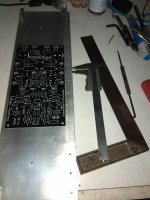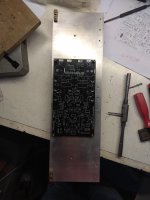Hi Valery,
already using peeceeebee V4 for LXmini ,recently crescent tried V4 with his SMPS and praised it other forum,I just wanted his opinion , if he says this is better than V4 , thought of giving it a go, any how thanks for your opinion, will try it after the pandemic
already using peeceeebee V4 for LXmini ,recently crescent tried V4 with his SMPS and praised it other forum,I just wanted his opinion , if he says this is better than V4 , thought of giving it a go, any how thanks for your opinion, will try it after the pandemic
+1 Not to forget their absence of the diode junction between the base and emitter of BJTs, so, their immunity to parasitic HF signals.Although I love jFETs at the input. It's a pity the choice becomes narrower every year.
As long as there are people left to use their ears to listen, that is, to use observation rather than submission to simplistic theories and blind belief in measurements alone, not all will be lost in the more and more desert world of high fidelity. Thank you for this.Hi Drgnanam,
You need to hear it in a good system. It's a completely different story.
I don't know why many people under-value no-global-loop / low-global-loop designs. An important advantage of Simpelstark family - accurate phase handling.
Human's hearing system is much more sensitive to phase, than it is to amplitude. Our brain understands direction where the sound comes from, based on the combination of phases, registered by each ear. I think, this is one of the reasons for fantastic soundstage, produced by this amplifier,
and I believe this is a key component of success for many tube-based amplifiers as well.
As Cresnet mentioned, this is something difficult to describe. Very natural sound with "higher than normal" level of instruments separation - that's the best description I can give 🙂
You know, it's still like describing the taste of an excellent dish in the restaurant 😀 Unless you try it - any words are not enough, as they don't cover all the nuances of its taste. By the way, some people may still not like it. But for many others it's delicious
Last edited:
Hi Valery, Jeff,
When do you plan on selling the AX3 PCBs? Since you’re using input BJTs instead of JFets, can we expect a very similar sound signature?
I’ve assembled the SimpelStark+ and really like it and I’m looking forward to this new one but hoping it will sound the same.
Thanks
Do
When do you plan on selling the AX3 PCBs? Since you’re using input BJTs instead of JFets, can we expect a very similar sound signature?
I’ve assembled the SimpelStark+ and really like it and I’m looking forward to this new one but hoping it will sound the same.
Thanks
Do
Hi Valery, Jeff,
When do you plan on selling the AX3 PCBs? Since you’re using input BJTs instead of JFets, can we expect a very similar sound signature?
I’ve assembled the SimpelStark+ and really like it and I’m looking forward to this new one but hoping it will sound the same.
Thanks
Do
Hi Do,
Good to hear from you 🙂
The sound signature is going to be rather similar - I have tried to preserve the key design principles and overall topology unchanged, although there are a few minor improvements here and there - just the refinements built on success of the previous design.
Jeff is running various tests, looking good so far - hope the boards will be available soon.
Cheers,
Valery
As long as there are people left to use their ears to listen, that is, to use observation rather than submission to simplistic theories and blind belief in measurements alone, not all will be lost in the more and more desert world of high fidelity. Thank you for this.
I'm hopeful after reading this, and of course earlier comment about the 'natural' sound of zero FB amps from Valery.
I am amazed at how many very clever, credentialled people cling to their zero THD beliefs - and I'm astonished how nasty this argument has become from mature, logical people who for some reason are threatened by this and similar amps. If Charles Hansen can echo Valery's thoughts, a science graduate in physics, I guess in a few more decades most educated people will come to see that the ear is very discerning and very subtle. Of course, this is not specially an issue of educated v. audiophiles, but it certainly seems that way sometimes.
I live for a time in the future when zero THD amplifiers are regarded as 'effects boxes'.
Last edited:
Hi Valery,
Great to hear it is very similar. I thoroughly enjoy the SimpelStark+ amplifier. There something that really grabs you, make you want to stay and listen non-stop. I can't explain it, it's just very enjoyable!
The SimpelStark+ is powerful enough to easily drive my Troels ATS-4 91dB speakers to ear bleeding levels, but as you know, I'm always looking for something to build! Since I love the SimpelStark+, I will most definitely try this next version.
Thanks
Do
Great to hear it is very similar. I thoroughly enjoy the SimpelStark+ amplifier. There something that really grabs you, make you want to stay and listen non-stop. I can't explain it, it's just very enjoyable!
The SimpelStark+ is powerful enough to easily drive my Troels ATS-4 91dB speakers to ear bleeding levels, but as you know, I'm always looking for something to build! Since I love the SimpelStark+, I will most definitely try this next version.
Thanks
Do
Here's an updated build guide for the Simpelstark boards.
THD is low enough and have monotonic harmonic profile.
I think it not because no global negative feedback, but if we can design amplifier with global negative feedback with SAME measurement like this, it will sound same.
My friend have developed solid state amplifier base on my design, with very high "loop gain" and it almost sound like very good tube amplifier. It is not about the technique, but the GOAL.
Hello Jeff
greetings and thanks for the updated build guide now schematic is clear
warm regards
Andrew
greetings and thanks for the updated build guide now schematic is clear
warm regards
Andrew
THD is low enough and have monotonic harmonic profile.
I think it not because no global negative feedback, but if we can design amplifier with global negative feedback with SAME measurement like this, it will sound same.
My friend have developed solid state amplifier base on my design, with very high "loop gain" and it almost sound like very good tube amplifier. It is not about the technique, but the GOAL.
Hi Bimo,
This is a rather complicated point. I tried many different approaches and ran many listening tests in high-end systems. Im general, my experience show better stereo sound reproduction quality in case of lower amount of feedback loop. There are many qualities we normally don't take in account, as well as some other qualities - I'm sure - we never take in account. We don't even know they exist.
One example - phase response fluctuation (phase jitter). Some amplifiers demonstrate noticeable issue in this area, ruining the sound source localization accuracy, making the music sound like somewhat "in the fog". I don't know how to describe it in a better way. Some designers don't even know it exists. One of the solutions here - additional relatively low-ohm VAS load, making the overall load independent of the OPS input impedance fluctuation. But this requires low global loop gain as you don't have too much OLG to "kill".
The other example - Maximum-Length Sequence (MLS) test. Some amplifiers demonstrate noticeable "noise ground" increase as soon as MLS signal is up and running - some of them utilize a lot of global feedback - meaning they introduce many unwanted HF interference components, falling into the audio range, spoiling the sound of higher mids.
ODNF is also an interesting thing - in general, it's a global loop, but having an unusual way of application. Cleaning a lot of "garbage" above 5-10 KHz.
This design is rather successful in playing "difficult" material with the highest level of naturality. You close your eyes and in a minute start thinking the violin quartet is sitting in your room. You hear every nuance of each player. And you clearly hear where each of them sits. These are the goals 😀
After all, this was an experiment that brought a very good result. Unlike some other experiments 😛 My new designs are based on that, with much better understanding of the key principles and mechanisms in place.
Cheers,
Valery
Last edited:
I tried to keep it actual size but Windows always seems to find a way to mess things up. setting an empty board on top to verify the size would be a good idea.
I did check the template by taking a print out on a A4 sheet and the holes and board size does not match. As Jeff pointed out something wrong with the Word doc when printed. There is a different 2-3mm on every mounting hole.
Printer software likes to resize everything for us too. A cheap transfer punch set and board are the safest bet. HHIP 8600-0041 28 Piece Transfer Punch Set, 3/32"-1/2": Amazon.ca: Industrial & Scientific
- Home
- Amplifiers
- Solid State
- No-global-loop amplification

